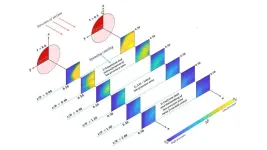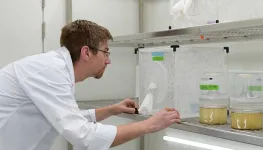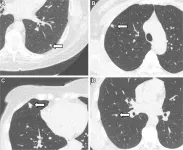(Press-News.org) WASHINGTON, Aug. 13, 2024 – Key to winning a cricket match is tricking the other team’s batters – no small feat as bowlers bowl cricket balls nearly 100 miles per hour. In recent years, a bowling technique that has become popular involves keeping the arm almost entirely horizontal during delivery, notably used by Sri Lankan stars Lasith Malinga and Matheesha Pathirana. The aerodynamics of such deliveries have perplexed sports physicists.
In Physics of Fluids, by AIP Publishing, researchers have started to unravel the mysteries of how such a bowling action leads to such tough-to-hit balls. Using a wind tunnel, Faazil et al. have described the changes in pressure fields surrounding a ball due to the spinning brought on by bowling with a near-horizontal arm.
“The unique and unorthodox bowling styles demonstrated by cricketers have drawn significant attention, particularly emphasizing their proficiency with a new ball in early stages of a match,” said author Kizhakkelan Sudhakaran Siddharth. “Their bowling techniques frequently deceive batsmen, rendering these bowlers effective throughout all phases of a match in almost all formats of the game.”
The amount and way that a cricket ball jukes along its trajectory heavily relies on the interplay between the spin of the ball and operational Reynold’s number, a dimensionless quantity that relates fluid density, ball dimension, air speed, and fluid viscosity.
To get to the heart of their question, the team employed a wake survey rake device made of multiple tubes designed to capture the pressure downstream of the ball. This was complemented by an imaging system capable of detecting pressure variations sensed in the connected manometers. The study examined the flow dynamics of cricket balls rotating up to 2,500 revolutions per minute in a wind tunnel.
“The simultaneous traversal-imaging technique combined with the traditional manometers utilized in this study yielded remarkable precision, exceeding all expectations,” Siddharth said. “This demonstrated to be an outstanding approach for replicating the intricate and dynamic situations experienced in sports contexts within a wind tunnel setting.”
The group found that low-pressure zones expanded and intensified near the ball when spinning, while these zones shifted and diminished downstream. At higher spin rates, the low-pressure zone begins to change to a persistent bilobed shape.
The results lend support to the theory that these newer bowling techniques tap into the Magnus effect, in which high-speed spinning creates effects that shift the ball midflight.
Siddharth hopes the work stokes further interest in understanding the physics of cricket ball dynamics. The group looks to investigate how other factors, such as wear on the ball, affect aerodynamics.
###
The article “Unraveling the near vicinity pressure field of a transversely spinning cricket ball” is authored by Aafrein Begam Faazil, Abdul Rahim Farhatnuha, and Kizhakkelan Sudhakaran Siddharth. It will appear in Physics of Fluids on Aug. 13, 2024 (DOI: 10.1063/5.0215749). After that date, it can be accessed at https://doi.org/10.1063/5.0215749.
ABOUT THE JOURNAL
Physics of Fluids is devoted to the publication of original theoretical, computational, and experimental contributions to the dynamics of gases, liquids, and complex fluids. See https://aip.scitation.org/journal/phf.
###
END
Cricket physics: Science behind the modern bowler technique tricking batters
Wind tunnel experiments reveal why bowling with a near horizontal arm makes for tough batting.
2024-08-13
ELSE PRESS RELEASES FROM THIS DATE:
Measuring Martian winds with sound
2024-08-13
WASHINGTON, Aug. 13, 2024 – Mars has a notoriously inhospitable environment, with temperatures that fluctuate dramatically over the course of a Martian day and average minus 80 degrees Fahrenheit. Its surface is mostly covered in red dust, with terrain typified by craters, canyons, and volcanoes. And its atmosphere is extremely thin, comprising only about 1% of the density of Earth’s.
Needless to say, measuring wind speeds on the red planet is challenging. Martian landers have been able capture measurements — some gauging the cooling rate of heated materials ...
Posttraumatic stress disorder and type 2 diabetes outcomes in veterans
2024-08-13
About The Study: The findings of this cohort study of patients with comorbid posttraumatic stress disorder (PTSD) and type 2 diabetes suggest that PTSD is a modifiable risk factor associated with a modest reduction in microvascular complications. Further research is needed to determine whether findings are similar in non-Veterans Health Administration health care settings.
Corresponding Author: To contact the corresponding author, Jeffrey F. Scherrer, PhD, email jeffrey.scherrer@health.slu.edu.
To access the embargoed study: Visit our For The Media website at this link https://media.jamanetwork.com/
(doi:10.1001/jamanetworkopen.2024.27569)
Editor’s ...
Smartwatch measures of outdoor exposure and nearsightedness in children
2024-08-13
About The Study: In this 1-year prospective cohort study of children with smartwatches, continuous outdoor exposure with at least 15 minutes accompanied with no less than 2,000 lux sunlight intensity was associated with less myopic shift. These findings suggest that future outdoor interventions should focus not only on the overall time outdoors but also on the effective outdoor exposure patterns, as a means to effectively prevent myopia (nearsightedness) in children.
Corresponding Authors: To ...
Lurie Children’s Hospital awarded $12 million by PCORI to study best approach to treat mild pneumonia in young children
2024-08-13
Ann & Robert H. Lurie Children’s Hospital of Chicago, in partnership with University of Utah Health, has been approved for $12 million in research funding by the Patient-Centered Outcomes Research Institute (PCORI) for a study that will compare two ways to use antibiotics in young children with mild pneumonia, one of the leading reasons children seek acute care, who are well enough to be cared for at home.
The first approach is to prescribe and give antibiotics immediately, which is the current standard of care. The second way is to prescribe an antibiotic but not give it unless the child’s symptoms worsen or ...
PCORI announces $165 million in funding for new health research
2024-08-13
PCORI announces $165 million in funding for new health research
Approved awards support patient-centered comparative clinical effectiveness research (CER) on telehealth interventions, heart care and various health concerns
Aug. 13, 2024
WASHINGTON, D.C. – The Patient-Centered Outcomes Research Institute (PCORI) today announced the approval of funding awards totaling more than $165 million for new patient-centered comparative clinical effectiveness research (CER), as well as research to improve methods and strengthen the science of engagement in patient-centered CER. Among the 10 CER studies awarded, three will evaluate the effectiveness of telehealth interventions ...
Study finds emergency department visits by children associated with water beads more than doubled from 2021 to 2022
2024-08-13
(COLUMBUS, Ohio) – Researchers from the Center for Injury Research and Policy and Central Ohio Poison Center at Nationwide Children’s Hospital have found more than an estimated 8,000 visits to U.S. emergency departments (EDs) associated with water beads from 2007 through 2022, and the number of these visits increased rapidly by more than 130% from 2021 to 2022.
In a study published in American Journal of Emergency Medicine, researchers analyzed 16 years of data and call for a more comprehensive regulatory approach to prevent water bead-associated injuries. The increase in ...
Reduce, reuse, reflycle
2024-08-13
A Macquarie University team proposes using genetically engineered black soldier flies (Hermetia illucens) to address worldwide pollution challenges and produce valuable raw materials for industry, including the USD $500 billion global animal feed market.
In a new paper published on 24 July in the journal Communications Biology, scientists at Macquarie University outline a future where engineered flies could transform waste management and sustainable biomanufacturing, addressing multiple United Nations Sustainable Development Goals (SDGs).
Synthetic biologist Dr Kate Tepper is lead author of the paper and a Postdoctoral Research Fellow at Applied BioSciences, Macquarie University.
“One ...
Lung nodules seen in a high percentage of non-smokers
2024-08-13
OAK BROOK, Ill. – A new study of more than 10,000 non-smoking adults found that solid lung nodules were present in a considerable portion of study participants. Non-smokers are traditionally thought to be at low risk for lung nodules and lung cancer. The results of the study were published today in Radiology, a journal of the Radiological Society of North America (RSNA).
Incidental lung nodules are common findings on chest CT and in high-risk groups are more likely to be a sign of early-stage lung cancer. Because most previous research on the prevalence and size of lung nodules has typically been ...
Study shows text messages help youth at risk for suicide feel supported after discharge
2024-08-13
(COLUMBUS, Ohio) – As the nation’s youth mental health crisis continues, providers continue to find ways to help address gaps in care. Patients who receive care for suicidal thoughts and behaviors need extra support as they transition after they are discharged from inpatient care or the emergency department.
Caring Contacts are validating messages sent to patients via text messages, postcards or letters to offer patients ongoing care and support without placing any demands (such as reminders to attend their next appointment). At Nationwide ...
About 10,000 chemistry presentations will happen in Denver soon
2024-08-13
WASHINGTON, Aug. 13, 2024 — The American Chemical Society (ACS) is hosting ACS Fall 2024, its virtual and in-person meeting, with the theme “Elevating Chemistry.” It will take place in Denver on Aug. 18-22.
About 10,000 presentations will feature cutting-edge developments on a range of scientific topics at ACS Fall 2024. Embargoed press releases and videos are available to members of the media on the EurekAlert! website. Reporters can also email newsroom@acs.org to request access to the embargoed content. View the ACS Fall 2024 schedule for a full list of in-person, hybrid ...
LAST 30 PRESS RELEASES:
How many insects fly in the sky above the USA?
Could cheese protect your brain health?
Who faces more difficulty recovering from stroke?
Colliding galaxies create the brightest, fastest growing black holes at their center
New BrainHealth research reveals tradeoffs on sleep with cannabis use for chronic pain
Aging-US now on ResearchGate, enhancing visibility for authors and readers
'Molecular glue' stabilizes protein that inhibits development of non-small cell lung cancer
Mount Sinai Health System is recognized in 2025 Chime Digital Health Most Wired survey
From prey to predator: How carnivores spread beneficial fungi
Menopause symptoms may be frequent and have negative effects, according to female endurance athletes
US Congressmembers’ responses on X to mass shooting events differ along party lines
KAIST-UEL team develops “origami” airless wheel to explore lunar caves
Individual genetic differences render some therapies ineffective
Engineering dendritic cells boosts cancer immunotherapy
Sophisticated neuroimaging reveals PTSD in WTC responders is linked to measurable physical changes in brain structure
Health policy experts identify promising strategies for providing health care to homeless people
Study explores role of neutrophils in canine atopic dermatitis
Mayo Clinic researchers develop AI-ECG model to diagnose liver disease earlier
Heavy menstruation common among teenage girls – questionnaire reveals risk of iron deficiency
New study explores why open water swimming feels so powerful for midlife women
In echo of Jurassic Park, mosquitoes capture entire ecosystems in their blood meals
Marty Cooper, Illinois Tech Alumnus and ‘Father of the Cell Phone,’ Receives 2025 Marconi Society Lifetime Achievement Award
How to reduce the risk of lymphedema
NEJM Evidence and CIDRAP announce Public Health Alerts
New fossil study illuminates on the evolutionary success of frogs
Patient-specific human liver model to understand disease mechanisms
Confused by the doctor's questionnaire? U of A study suggests it's common
How do brains stay stable, and when might a dose of flexibility be helpful?
mRNA revitalizes aging immune systems—the liver as a fountain of youth
Rural-urban differences in the prevalence of chronic pain among adult cancer survivors
[Press-News.org] Cricket physics: Science behind the modern bowler technique tricking battersWind tunnel experiments reveal why bowling with a near horizontal arm makes for tough batting.





